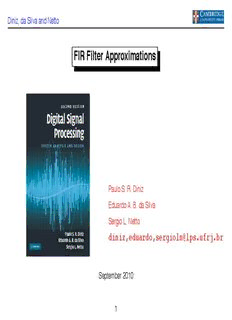
FIR Filter Approximations - i3s PDF
Preview FIR Filter Approximations - i3s
Diniz, da Silva and Netto FIR Filter Approximations Paulo S. R. Diniz Eduardo A. B. da Silva Sergio L. Netto diniz,eduardo,[email protected] September 2010 1 Diniz, da Silva and Netto Contents Ideal characteristics of standard filters • – Lowpass, highpass, bandpass, and bandstop filters – Differentiators – Hilbert transformers FIR filter approximation by frequency sampling • FIR filter approximation by window functions • – Rectangular window – Triangular windows – Hamming and Hann windows – Blackman window – Kaiser window – Dolph-Chebyshev window 2 Diniz, da Silva and Netto Contents (cont.) Maximally-flat FIR filter approximation • FIR filter approximation by optimization • – Weighted-least-squares method – Chebyshev method – WLS-Chebyshev method Do-it-yourself: FIR filter approximations • 3 Diniz, da Silva and Netto Ideal characteristics of standard filters H( jω) h(n) As seen in Section 2.8, the relationship between e and is given by the • following pair of equations: H( jω) = h(n) −jωn e e (2) ∞ " n=− π 1 ∞ h(n) = H( jω) jωn ω e e d (3) 2π # −π H( jω) h(n) In what follows, we determine e and related to ideal standard filters. • 8 Diniz, da Silva and Netto Lowpass, highpass, bandpass, and bandstop filters The ideal magnitude responses of some standard digital filters are depicted below. • j! j! |H(e )| |H(e )| 1 1 (a) !c " 2" ! (b) 0 !c " 2" ! j! j! |H(e )| |H(e )| 1 1 (c) 0 !c1 !c2 " 2" ! (d) 0 !c1 !c2 " 2" ! Figure 1: Ideal magnitude responses: (a) lowpass; (b) highpass; (c) bandpass; (d) band- stop filters. 9 Diniz, da Silva and Netto Lowpass, highpass, bandpass, and bandstop filters For instance, the lowpass filter, as seen in Figure 1a, is described by • 1, |ω| ω for c |H(ejω)| = ≤ (4) 0, for ω < |ω| π c ≤ Using (3), the impulse response for the ideal lowpass filter is • ω c , n = 0 for ω 1 c π h(n) = jωn ω = e d (5) 2π #−ω sin(ωcn) c , n = 0 for πn " One should note that in the above inverse transform calculations we have supposed • that the phase of the filter is zero. 10 Diniz, da Silva and Netto Lowpass, highpass, bandpass, and bandstop filters From Section 4.2.3, we have that the phase of an FIR filter must be of the form • −jωM M e 2 , where is an integer. M M Therefore, for even, it suffices to shift the above impulse response by 2 • M M samples. However, for odd, is not an integer, and the impulse response must 2 be computed as ω 1 c h(n) = −jωM jωn ω e 2 e d 2π # −ω c ω 1 c = jω(n−M) ω e 2 d 2π # −ω c ω n − M sin c = 2 (6) π n − M ! " #$ 2 " # 11 Diniz, da Silva and Netto Lowpass, highpass, bandpass, and bandstop filters Likewise, for bandstop filters, the ideal magnitude response, depicted in Figure 1d, is • given by 1, 0 |ω| ω for c ≤ ≤ 1 |H(ejω)| = 0, for ωc < |ω| < ωc (7) 1 2 1, ω |ω| π for c 2 ≤ ≤ Then, using (3), the impulse response for such an ideal filter is • ω π −ω 1 c c 1 2 h(n) = jωn ω + jωn ω + jωn ω e d e d e d 2π # # # % −ω ω −π & c c 1 2 ω − ω c c 1 + 1 2 , n = 0 for π = (8) 1 [ (ω n) − (ω n)] , n = 0 sin sin for c c πn 1 2 " 12 Diniz, da Silva and Netto Differentiators An ideal discrete-time differentiator is a linear system that, when samples of a • band-limited continuous signal are used as input, the output samples represent the derivative of the continuous signal. x (t) −π, π More precisely, given a continuous-time signal band-limited to , a T T • x(n) = x (nT) when its corresponding sampled version is input to an ideal a ! # y(n) differentiator, it produces the output signal, , such that x (t) d a y(n) = (9) t d ’t=nT ’ ’ X ( Ω) If the Fourier transform of the continuous-time si’gnal is denoted by j , we a • ΩX ( Ω) have that the Fourier transform of its derivative is j j . a 14 Diniz, da Silva and Netto Differentiators Therefore, an ideal discrete-time differentiator is characterized by a frequency • response, up to a multiplicative constant, of the form H( jω) = ω, −π ω < π e j for (10) ≤ The magnitude and phase responses of a differentiator are depicted in Figure 2. • 15
Description: